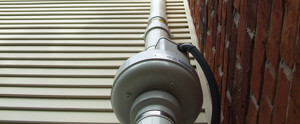Live Well, Breathe Well
St. Louis Real Producers Magazine - July 2021
Cherie Summa | St. Louis Radon Test and Mitigation
Live Well, Breathe Well
Radon is a colorless, odorless, naturally occurring gas. It’s also the leading cause of lung cancer in non-smokers, according to EPA estimates.
“You can’t see it, taste it, or smell it, but it can be dangerous if at elevated levels in homes or other buildings,” Cherie Summa explains. “It’s naturally occurring and comes from the breakdown of uranium in rocks and soil underneath your house.”
The major factors that influence the movement of radon into a home include the uranium and radium concentrations of the rock and soil beneath the home, pathways through the rocks and soil to the base of the home, openings to the soil directly into the inside of the home, and the amount of suction created by airflow within the home. Any type of home has the potential to have elevated levels of radon. Radon gas enters the home through the slab, basement, or crawl space, and both new and old homes can have elevated radon levels.
According to Cherie, radon exposure is also the sixth leading cause of cancer mortality in the United States, and nearly one out of every four homes in the state of Missouri has elevated radon levels. As Cherie says, “It’s a real and genuine health concern.”
Experience Matters
While radon is an essential issue in any home, it’s often overlooked outside of real estate transactions. With so much on the line, it’s imperative to use a certified radon contractor. Unfortunately, certification is not currently required in Missouri, meaning that many companies aren’t performing tests or installing mitigation systems to the industry standard.
St. Louis Radon Test and Mitigation, on the other hand, is certified, licensed, and experienced. They’ve been in business for 13 years and have installed over 13,000 mitigation systems. Most of their installers have nearly a decade of experience in the radon industry.
“We are the largest, most experienced radon company in Missouri,” Cherie says.
Cherie herself is a licensed civil engineer with over two decades of experience. She has been the owner of St. Louis Radon Test and Mitigation since 2015. She’s also on the board of Lung Cancer Connection and is involved with the Missouri Lung Cancer Consortium, which supports radon testing and certification requirements in Missouri.
“Many people assume all radon systems are installed the same and don’t realize the importance of correct radon test placement, but companies that are certified are held to high standards and are required to follow strict radon testing and mitigation standards. There’s not a lot of awareness,” Cherie continues. “If a radon test is not set in the right place, you’re not going to get valid results. The most common mistake we run into when it comes to testing is not placing enough radon tests. Most companies only place one test no matter what the footprint of the house is or how many foundation types there may be. For instance, if there is a basement and a crawl space in a house, it would need two tests. Any time there is more than one type of foundation, every foundation needs to be tested. If the footprint is over 2000 square feet, you need more than one radon test.”
For mitigation system installations, certification provides guidance on how these systems are installed. An incorrectly installed system can damage a house, cause radon reentry, or elevate radon levels further.
Protecting Your Family
The good news is that radon-induced lung cancer is preventable. All it takes is awareness, followed by testing and potential mitigation.
“Every single house should be tested,” Cherie says. “Every single person that lives in a house, condo, or apartment should be testing for radon every two years, even if they have a mitigation system.”
Cherie recommends starting with the standard 48-hour test. If the results are borderline, a longer-term test can help the homeowner decide if mitigation is necessary. St. Louis Radon also does commercial radon testing and mitigation.
“Radon does fluctuate,” Cherie says. “For example, it can be higher in the winter than in the summer. During a real estate transaction, people are sometimes misled when their results are depicted as pass or fail. The actual numbers are meaningful and may suggest a follow-up test should take place again after you move in, when you are sure the house is closed up. The EPA action level is 4.0 pCi/L. If you have a reading above 3.0 pCi/L, it would be a good idea to retest in the winter.”
If you have a question or concern about radon testing or mitigation, the first step is to call a certified professional like Cherie. With top-notch training and experience, you’ll be in good hands.
“Radon testing and mitigation is no different than any other home improvement or contract work. It makes sense to use a certified or licensed professional who is an expert in their field.”
For more information, please visit www.stlradon.com.




